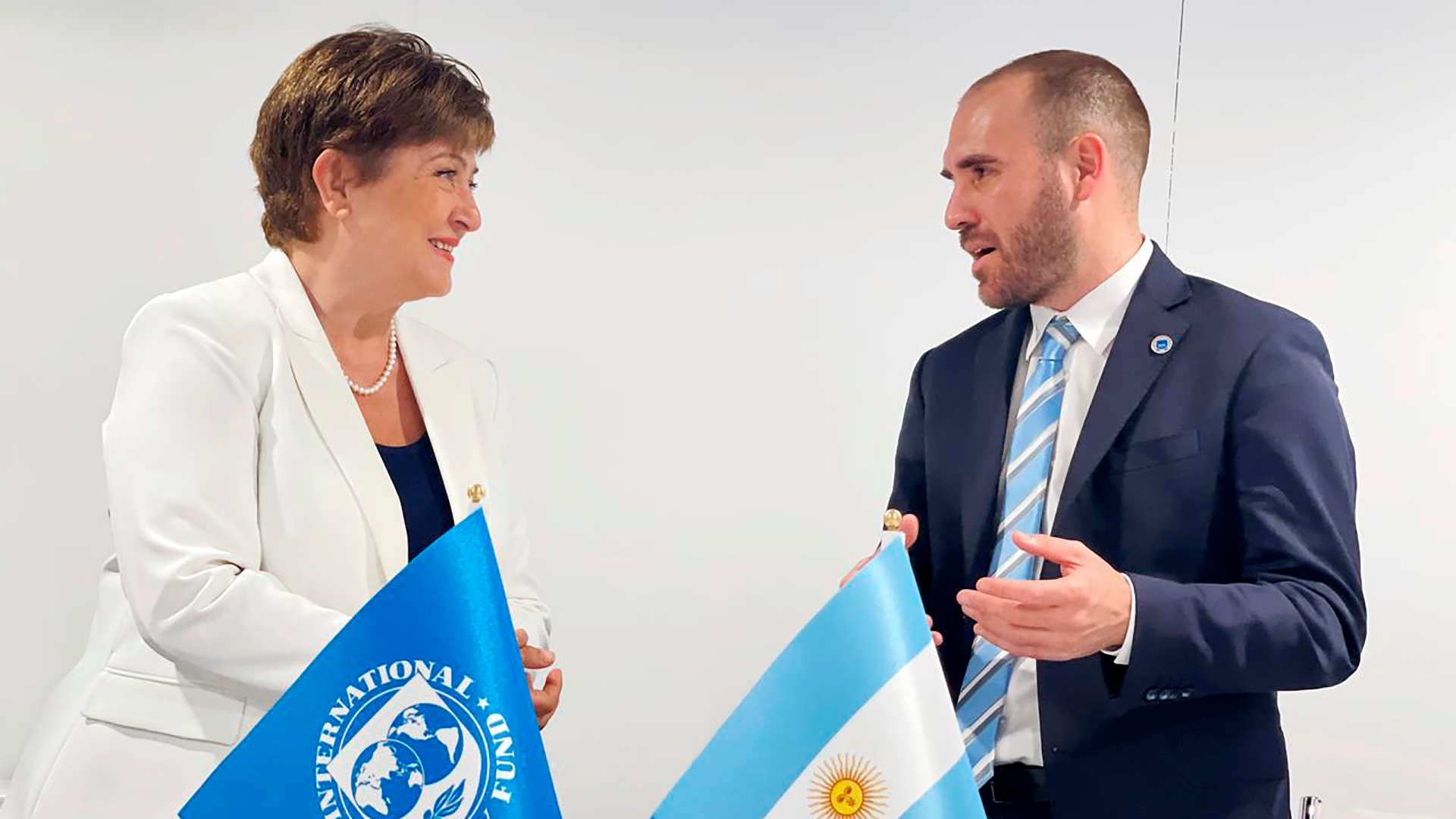The relaunch of the program agreed by the Argentine government and the IMF and signed on March 25, 2022 was, at this point, practically inevitable. Not only had the reserve goals already been changed, but the Fund itself projected in its most recent “World Economic Panorama” that Argentine inflation this year would be 88% instead of the 60% projected in the agreement and in the budget voted by Congress.
In addition, according to the Fund, in 2023 Argentina’s GDP, instead of growing 2%, as the agreement and the budget said, would only grow 0.2%, 90% less. An adjustment like this radiates macroeconomic changes everywhere: collection, spending and fiscal deficits, employment levels, salary effects, exports and imports, trade balance and a long etcetera, which force an important reformulation so that the program ceases to be a series of policies and objectives that no one believes in, including the signatories themselves.
He March 25, 2022the IMF board approved and formalized the start of a new financial program with Argentina, of the type Extended Fund Facility (EFF) to refinance the credit stand by that the government of Mauricio Macri for USD 57,000 million and of which the Fund disbursed close to USD 44,000 million. After several months of discussions, a 30-month schedule was agreed upon, with the unusual feature of quarterly disbursements sufficient to cover SBA payment obligations for 2018, and then a period until 2032 to repay the entire credit. In this context, on Friday, March 31, the IMF board approved the fourth and most recent review of the agreement and approved a disbursement of 4,000 million Special Drawing Rights (SDRs), the “currency” of the Fund, just under $5.4 billion.
How did it get here? It is worth remembering the main milestones of an already complicated relationship.
1 – Approval and first alerts: the agreement began in the midst of a context that forced a first reconsideration on the numbers embodied in the program, due to the net effects of the invasion of russia Ukraine, which caused the jump in the international prices of raw materials and also energy, with a strong impact on the national and world economy. The IMF considered that it was a “credible and realistic” program but quickly warned about the change in international conditions and hurried a reconsideration of the assumptions of the agreement. This was manifested when the IMF board stated in a statement that due to the war in Eastern Europe the risks to the program were “exceptionally high”.
2 – Martín Guzmán resigns: after a trip by the Prime Minister of Economy of Alberto Fernandez to the US to meet with Ilan Goldfajn -who would resign months later to assume the IDB-, the first quarterly review concluded with all the approved objectives -those that corresponded to the end of March 2022. But also with some first modifications to the central numbers regarding quarterly goals. Mainly, due to nominal readjustments for those that are expressed in pesos due to higher inflation.
It was the first and last review in which Guzmán participated. On July 2, just under a month after passing the first test before the IMF, the then minister announced his departure from the Ministry.
3 – Silvina Batakis, the fleeting replacement: After the departure of the Prime Minister of the Economy from the Frente de Todos government, he took office at the Palacio de Hacienda who until then was Secretary of Provinces of the Ministry of the Interior. One of her first announcements was that the program with the Fund would continue without change. During her brief interregnum at the Palacio de Hacienda, she even went to Washington to support in person her conviction that the program was going to continue despite the ministerial change and to give a message of continuity. But his passage through the main chair of economic management was so fleeting that He did not even return from the North American capital and the Ministry already had a new leadership.

4 – Sergio Massa and the second revision: At the beginning of August the new and current Minister of Economy finalized his transfer from the presidency of the Chamber of Deputies. He assembled his team of energy officials, presented a first series of measures -among them, a deeper scheme of rate segmentation to which Guzmán had announced and a strong fiscal signal in the face of a scenario of strong expansion of public spending in the first part of the year.
His first mission was to approve the second quarterly review, which took place in September. The picture was less favorable for the Executive Branch in that second review: breached two of the goals included: the accumulation of Bookings, which was attributed to the higher-than-expected use of dollars for energy imports and delayed disbursements from international organizations. The other objective that was not achieved was the tax collection floor.
Sergio Massa had to use more reserves to import energy last winter
5 – First “flexibility” of goals: In that instance, there was already a change in the commitment to collect reserves in the BCRA. In a first exercise of the recalculation of that objective that is being carried out these days, the IMF and the Government agreed to cut the 2022 goal by some USD 800 million, which was USD 5.8 billion, to USD 5,000 million. In any case, strictly speaking, it was a “deferral” of those USD 800 million, since they were added to the minimum threshold of 2023, which went from USD 4,000 million to USD 4,800 million. Months later, that number would also end up being cut after a new negotiation.

6 – Closing of 2022 and “soybean dollar”: in December also took place the third reviewwhich gave rise a few days before Christmas to the fourth disbursement, for $5.9 billion. The IMF report, approved by the board, came with a series of warnings about what would arrive in 2023. In the first place, it already alerted about the possible impact of the drought. The second, a discouragement to the reiteration of the soybean dollarwhich had already had two editions but which had served to meet the goals of accumulation of reserves. And finally, the risk of a lack of control of the public spending during the months before the elections.
7 – Recalibration of goals: In the first days of March, the IMF agreed with the national government on a change in the perspective of reserve accumulation, less demanding in the remainder of the year as a consequence of the macroeconomic impact that the severe drought that affects agricultural production. As reported by Economía, the quarterly guideline will be reduced by about $3 billion and the annual, in about $2 billion. For the moment, the IMF did not give details on that central point. The fiscal and monetary ones were maintained.
8 – Warnings for public spending: In the last statement, the IMF warned about the moratorium and the delay in the implementation of the tariff segmentation scheme. “To meet the deficit reduction goals and strengthen the progressivity of energy subsidies, the authorities plan to continue implementing the agreed segmentation schemeeliminating subsidies for higher-income residential users starting in May and for commercial users by the end of 2023,” the staff said.
And finally, he stressed: “Early and determined measures will be taken to sustainably address the fiscal costs of the unexpected approval of the pension moratorium to ensure fiscal objectives for this year and the next ones.”
9 – Inflation exceeds 100%: the Consumer Price Index (CPI) for March marked 7.7%, well above what the market and the Government itself expected. Thus, the interannual price increase reached 104.7% and the annualized increase in the first quarter was close to 120 percent. The BCRA had already raised the interest rate, which it had frozen for six months, from 75 to 78% per year (effective rate of 113% per year) and now it may need to increase it again, to prevent the demand for assets in pesos from falling .
10 – The exchange and analysis of the Fund: Last week, the Ministry of Economy announced a forced exchange of bonds in dollars in the hands of State agencies and an auction of dollarized securities under local law to add financing to the Treasury and volume in the financial dollar market. It generated harsh criticism from the opposition about the cost of this type of operation.
In debt management it is necessary to improve the functioning of the domestic bond market, but it must be carried out in a way that does not increase vulnerabilities in the future (Kozack)
In this regard, the IMF spokesperson, julie kozack assured: “We are aware of the decision and we are evaluating it in accordance with the objectives of the program. In our opinion, in debt management it is necessary to improve the functioning of the domestic bond market, but it must be carried out in a way that does not increase vulnerabilities in the future and also must be accompanied by strict and consistent macroeconomic policies”.
Sources from the economic team had confirmed hours before that the official intention was to implement the exchange mechanism for part of the bonds in dollars in the hands of the public sector and to implement an auction system before the market for the remaining portion of dollarized securities. had been part of the technical discussions with the staff.
Keep reading:


